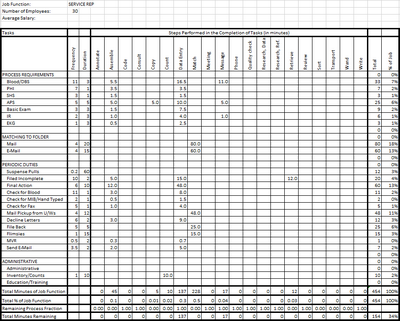Process Improvement Specialist

These are the main techniques I employ in process improvement.
- Lean Analysis is about reorganizing process steps to achieve greater efficiency. It deals with eliminating waste, handling constraints, making substitutions, and generally streamlining operations. It concerns throughput and resource consumption. The port-of-entry and medical office modeling tools were used to perform lean analyses but the biggest savings was realized on the business process reengineering engagements where I developed FileNet document imaging systems.
- Six Sigma is chiefly about reducing variation, but as a practical matter is about finding the cause of errors, correcting them, and taking steps to prevent them from even occurring. It concerns quality. I've done this in the paper industry, the steel industry, and in numerous software engineering contexts.
- Total Quality Management: I participated in quality improvement programs at three companies under this banner, which has since largely been subsumed by Six Sigma. This methodology provided the insight that quality is measured in terms of specific requirements.
- Tradespace Analysis is the process of exploring the effects of changing different operations and properties of a process. I was a member of a team that did this for logistics and maintenance activities for a number of years, and the medical office simulations supported the same process.
- Automation comes in many forms. I've done this whenever I've built a tool to streamline processes I was doing by hand. Automation also improves outcomes by increasing granularity in terms of doing things more often and in smaller increments. My real-time control system work realized savings in fuel costs and product loss.
- Software Engineering involves finding ways to do everything smaller, faster, cheaper, more accurately, more robustly, more transparently, and more maintainably. This has taken the form of continuously adopting new tools and techniques, understanding efficient algorithms, and taking advantage of improved technology.
- User Interface and Information Display methods can increase the situational awareness of users and analysts. The more information you can make available the more intuitive and accurate people's understanding of the system of interest will be, which will make them better able to make effective decisions. This website is full of examples of information displays and control and configuration methods I've created.
- Training is an excellent way to increase an individual's situational awareness.
- Economic Analysis: Economics is the science of making choices under conditions of scarcity. The question isn't, "What will it cost?" The proper question is, "What will it cost in compared to other options?" This can be measured in many units on many axes. Measuring in terms of money is just one (with a vast and specialized literature), and I've supported analyses of many kinds when cost information is made available.
There are always many ways to change a system or process, the key is to choose the ones with the highest marginal returns. This involves knowing what kind of improvement to apply in a given situation (e.g., once the 3% percent of code that consumes 85% of CPU cycles has been fully optimized it's clear that the balance of the code should be improved in terms of clarity, maintainability, and speed of development). Another crucial factor is understanding all of the causes and effects within your system and the ramifications of your decisions. You don't want to take what looks like shortcut now that will create worse problems in the future.

